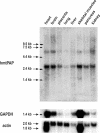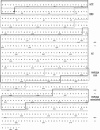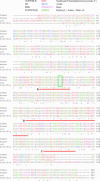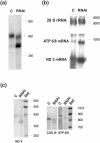Identification of a novel human nuclear-encoded mitochondrial poly(A) polymerase
- PMID: 15547249
- PMCID: PMC534615
- DOI: 10.1093/nar/gkh923
Identification of a novel human nuclear-encoded mitochondrial poly(A) polymerase
Abstract
We report here on the identification of a novel human nuclear-encoded mitochondrial poly(A) polymerase. Immunocytochemical experiments confirm that the enzyme indeed localizes to mitochondrial compartment. Inhibition of expression of the enzyme by RNA interference results in significant shortening of the poly(A) tails of the mitochondrial ND3, COX III and ATP 6/8 transcripts, suggesting that the investigated protein represents a bona fide mitochondrial poly(A) polymerase. This is in agreement with our sequencing data which show that poly(A) tails of several mitochondrial messengers are composed almost exclusively of adenosine residues. Moreover, the data presented here indicate that all analyzed mitochondrial transcripts with profoundly shortened poly(A) tails are relatively stable, which in turn argues against the direct role of long poly(A) extensions in the stabilization of human mitochondrial messengers.
Figures





Similar articles
-
Involvement of human ELAC2 gene product in 3' end processing of mitochondrial tRNAs.RNA Biol. 2011 Jul-Aug;8(4):616-26. doi: 10.4161/rna.8.4.15393. Epub 2011 Jul 1. RNA Biol. 2011. PMID: 21593607
-
Differential stability of mitochondrial mRNA in HeLa cells.Acta Biochim Pol. 2006;53(1):157-68. Epub 2005 Dec 21. Acta Biochim Pol. 2006. PMID: 16389406
-
Stable PNPase RNAi silencing: its effect on the processing and adenylation of human mitochondrial RNA.RNA. 2008 Feb;14(2):310-23. doi: 10.1261/rna.697308. Epub 2007 Dec 14. RNA. 2008. PMID: 18083837 Free PMC article.
-
Identification and properties of the genes encoding the poly(A) polymerase and a small (22 kDa) and the largest subunit (147 kDa) of the DNA-dependent RNA polymerase of molluscum contagiosum virus.Virology. 1995 Jul 10;210(2):471-8. doi: 10.1006/viro.1995.1364. Virology. 1995. PMID: 7618282
-
Human Misato regulates mitochondrial distribution and morphology.Exp Cell Res. 2007 Apr 15;313(7):1393-404. doi: 10.1016/j.yexcr.2007.02.004. Epub 2007 Feb 15. Exp Cell Res. 2007. PMID: 17349998
Cited by
-
The ribonucleotidyl transferase USIP-1 acts with SART3 to promote U6 snRNA recycling.Nucleic Acids Res. 2015 Mar 31;43(6):3344-57. doi: 10.1093/nar/gkv196. Epub 2015 Mar 9. Nucleic Acids Res. 2015. PMID: 25753661 Free PMC article.
-
Co-expression analysis identifies neuro-inflammation as a driver of sensory neuron aging in Aplysia californica.PLoS One. 2021 Jun 11;16(6):e0252647. doi: 10.1371/journal.pone.0252647. eCollection 2021. PLoS One. 2021. PMID: 34116561 Free PMC article.
-
Human mitochondrial RNA turnover caught in flagranti: involvement of hSuv3p helicase in RNA surveillance.Nucleic Acids Res. 2010 Jan;38(1):279-98. doi: 10.1093/nar/gkp903. Epub 2009 Oct 28. Nucleic Acids Res. 2010. PMID: 19864255 Free PMC article.
-
RNA-specific ribonucleotidyl transferases.RNA. 2007 Nov;13(11):1834-49. doi: 10.1261/rna.652807. Epub 2007 Sep 13. RNA. 2007. PMID: 17872511 Free PMC article. Review.
-
Evolution of miRNA Tailing by 3' Terminal Uridylyl Transferases in Metazoa.Genome Biol Evol. 2017 Jun 1;9(6):1547-1560. doi: 10.1093/gbe/evx106. Genome Biol Evol. 2017. PMID: 28633361 Free PMC article.
References
-
- Manley J.L. and Proudfoot,N.J. (1994) RNA 3′ ends: formation and function–meeting review. Genes Dev., 8, 259–264. - PubMed
-
- Dreyfus M. and Regnier,P. (2002) The poly(A) tail of mRNAs: bodyguard in eukaryotes, scavenger in bacteria. Cell, 111, 611–613. - PubMed
-
- Regnier P. and Arraiano,C.M. (2000) Degradation of mRNA in bacteria: emergence of ubiquitous features. Bioessays, 22, 235–244. - PubMed
-
- Hayes R., Kudla,J. and Gruissem,W. (1999) Degrading chloroplast mRNA: the role of polyadenylation. Trends Biochem. Sci., 24, 199–202. - PubMed
Publication types
MeSH terms
Substances
LinkOut - more resources
Full Text Sources
Molecular Biology Databases

